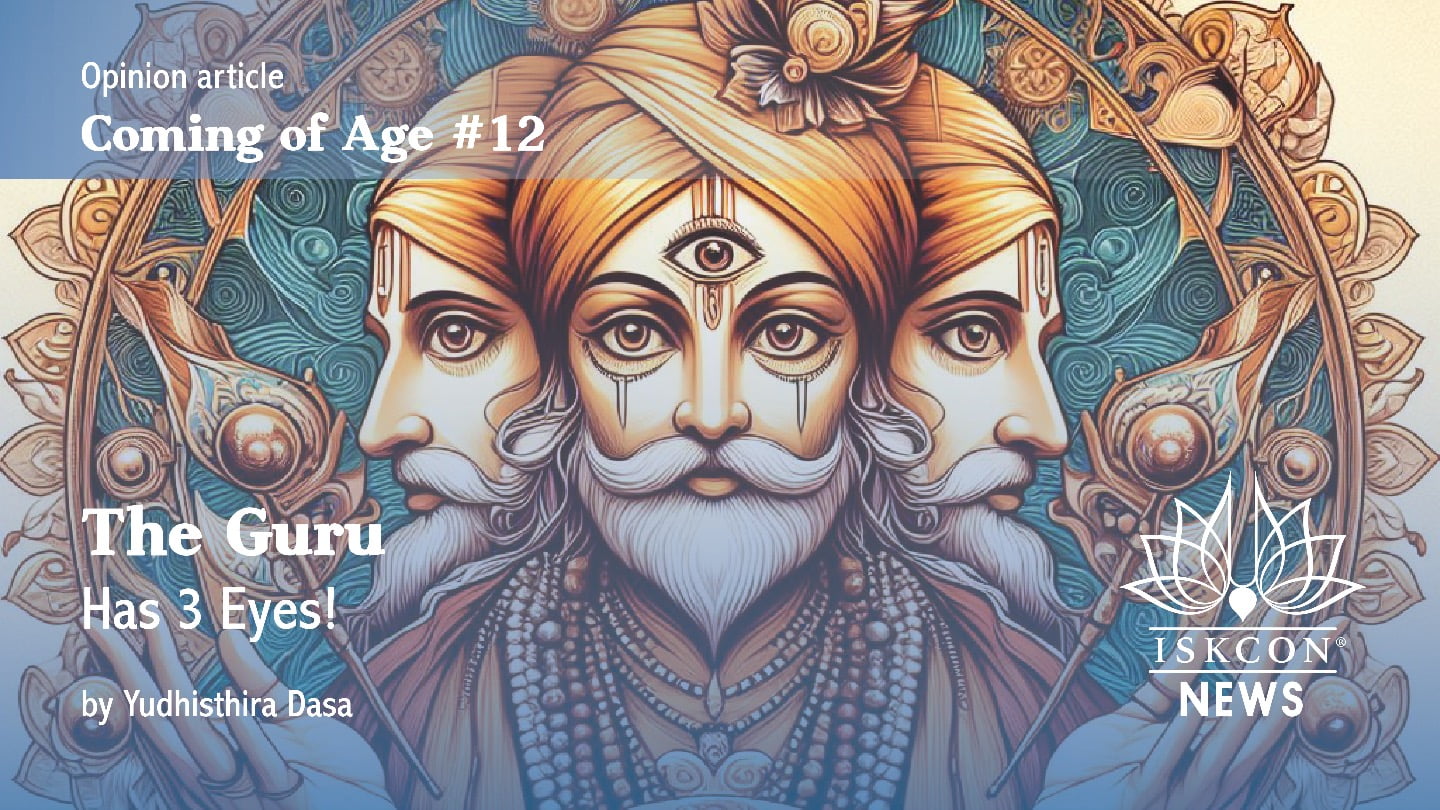COMING OF AGE #12 – The Guru Has 3 Eyes!
By Yudhisthira dasa | Feb 01, 2024

The science of advancing and making progress in life, material and spiritual, requires learning and growing. Guru Tattva is the name of the science of this process in Gaudiya Vaishnavism, a principle found in all bonafide traditions. There are three primary and specific types of gurus: vartma-pradarsaka-guru, diksa-guru, and siksa-guru. Let’s unpack this in our daily lives with as broad an understanding as possible. Why is a broad understanding important? Because ultimately, Krishna (God) is the broadest source of all sources, and His Divine Hand can be seen in all the experiences of sincere bhaktas in all faiths. Srila Prabhupada did not establish ISKCON as a once-a-week “pray and done” spiritual path.
Does the guru (teacher) really have three eyes? Yes and no. The concept of guru is by nature a never-ending river of mercy or grace, as the Supreme Person’s love manifests through the sending of so many teachers to inspire us to return to Krishna’s transcendental embrace. Here are the three eyes (words that start with the letter “I”).
INTRODUCE
We are all influenced by creative energy, but we are not creators. This means we can be profoundly affected by those around us in either a positive or negative way. In the case of being introduced to a bonafide spiritual path, very much including Gaudiya Vaishnavism, this introduction (or re-introduction) is of eternal benefit. These introductory teachers act as “touchstones” or “fire starters” acting on behalf of the Supreme Person through a lineage of qualified teachers. These are called vartma-pradarsaka-gurus. This type of guru is the first “I,” which sets us on the path towards eternal love and devotion.
INITIATE
The second “I” represents the diksa, or initiating guru, which is a singular relationship with varying degrees of ongoing guidance. In some cases, the disciple is guided directly throughout their lives by their initiating teacher. In other cases, the initiating guru plays a less active role with Krishna working through other teachers to inspire the practicing bhakta.
INSPIRE
This third “I,” siksa-gurus, supports the vartma-pradarsaka-gurus and the diksa guru throughout our lives in the material realm. This siksa guru or instructing guru category of teacher can be virtually unlimited as we open our hearts more and more on our individual journeys. After all, didn’t Lord Chaitanya use the humility of grass and tolerance of trees to be instructive and inspirational? This means that the souls in these grass and tree bodies are our gurus/teachers as we see more and more with the eyes of scripture.
“One should chant the holy name of the Lord in a humble state of mind, thinking oneself lower than the straw in the street; one should be more tolerant than a tree, devoid of all sense of false prestige, and should be ready to offer all respect to others. In such a state of mind, one can chant the holy name of the Lord constantly” (Chaitanya Mahaprabhu, Siksastakam Verse 3).
Researching this topic, we learn that all traditions have their various types of gurus or teachers. As Krishna says in one of the most famous verses of the Bhagavad Gita, “All of them—as they surrender unto Me—I reward accordingly. Everyone follows My path in all respects, O son of Partha (Arjuna)” (BG 4.11).
It clearly follows that since God’s love for all souls is infinite, He would act like a loving parent, namely, looking out for the long-term welfare of each and every soul. What a loving God to send unlimited teachers to guide and encourage us! From our side, since we have free will, we have moment-to-moment decisions to make. Do we take instruction and inspiration from the temporary, illusory energy that keeps us on the slow train: Back to Home, Back to Godhead, OR do we take the bullet train and seek out inspiration sent directly by the Supreme Lord to wake us up to our original blissful eternal state? If you are reading this, you probably prefer the bullet train if you can get to the station and purchase the correct ticket. What is the price of the ticket? We just have to wake up from this dream-like state.
One of the famous stanzas from Srila Bhaktivinode Thakur’s song begins with “Jiva Jago Jiva Jago.” Wake up, sleeping souls! How? Krishna directly and indirectly sends opportunities and messengers to inspire us. How often? At every moment. We need to wake up with humility and a desire to remember who we aren’t and who we really are. We are not these bodies, minds, and intelligence. We are eternal spirit souls. Jiva Jago!
Opinions expressed do not necessarily reflect the opinions and beliefs of ISKCON or ISKCON News.















